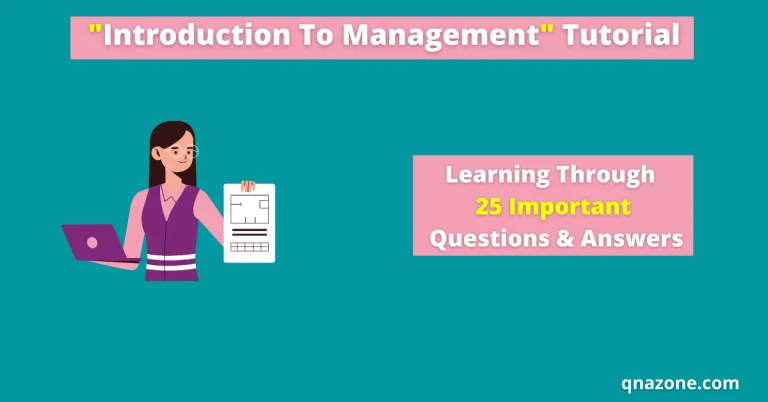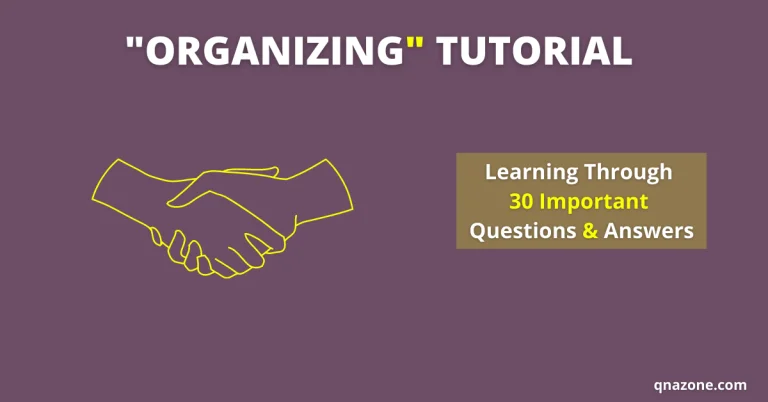20 Important Direction Questions and Answers [With PDF]
The 7th chapter of our Management learning course is “Direction”. In this article, we’ll learn the 20 most important direction questions and their answers.
It will help you understand the important direction terms and their explanations quickly.
By reading this post, you may quickly prepare for management courses and for any competitive tests such as school and college exams, vivas, job interviews, and so on.
So let’s get started…
Direction Questions and Answers
The 20 important direction questions and answers are as follows:
Question 01: What is Direction?
Answer: Direction entails issuing orders, providing advice and counsel to subordinates, supervising, and following.
Question 02: What is Supervision?
Answer: Supervision is the process of checking in on subordinates after giving them instructions and providing them with any necessary advice or counseling.
Question 03: What is the Direction of the Administration?
Answer: The direction is the heart of the administration.
Question 04: Who said the direction is the heart of the administration?
Answer: “Marshall E Dimuk,” said the direction is the heart of the administration.
Question 05: What is the Importance of Direction?
Answer: The importance of direction is as follows:
- Execution of the plan
- Organizational prime mover
- Workflow creation
- Control of employee behavior
- Improvement of employee standards and efficiency
- Initiation of dynamic leadership
Question 06: What are the Features of a Good Direction?
Answer: The important features or qualities of a good direction are as follows:
- Good direction must be logical.
- Perfection is an important aspect of good direction.
- The direction’s content should be presented in a beautiful and fluent manner in a few words.
- A good direction must be clear and unambiguous.
- Discipline is required for good direction.
- Punctuality is essential in direction.
- As far as possible, a good direction should be written.
Question 07: Why is it that Direction is always a Downward Process?
Answer: Direction has two sides: the giver of direction and the follower of direction. The first party gave orders to his direct subordinates.
In this manner, the department, subdivision, and individuals from above provide superior direction. As a result, the direction is always a downward process.
Question 08: What are the Various Methods or Techniques of Direction?
Answer: The various methods or techniques of direction are as follows:
- Direction by supervision
- Direction by communication
- Direction by leadership
Question 09: What is Direction by Supervisor?
Answer: Direction by supervision is the process of seeing the work in person after giving instructions and getting the work done with the necessary advice and counsel.
Question 10: What is Direction by Communication?
Answer: Direction by communication refers to instructing subordinates via various modes of communication such as telephone, mobile phone, circular, meeting schedule, discussion, email, internet, and so on.
Question 11: What is Direction by Leadership?
Answer: Direction by leadership refers to the directing technique used by a leader or manager to instruct subordinate manpower toward their endeavors using leadership strategies.
Question 12: What is Autocratic Direction?
Answer: Autocratic direction is the direction in which the superior decides on his own authority and power and tries to carry out the work by putting pressure or intimidation on the subordinates.
Question 13: What is Paternal Direction?
Answer: A paternal direction is one in which the superior, despite his superiority over his subordinates, does not exercise power in the performance of his duties, but instead influences his subordinates through affectionate and sincere use.
Question 14: What is Consultative Direction?
Answer: Consultative direction is used when the content of the direction is determined in consultation with those who will implement it prior to issuing the direction.
Question 15: What are the Features of consultative Direction?
Answer: The following are the main characteristics of consultative direction:
- Consultative direction is a type of strategy used in a democratic management system.
- In this case, the manager consults with his subordinates about the direction’s content before issuing it.
- Even if the direction is accepted, the superior retains the right to determine the content of the direction.
- In this case, the superior considers the advice of the subordinates and attempts to gain their support by expressing his own opinion.
- The goal of such a direction is to ensure subordinates’ spontaneous participation in the workplace.
Question 16: What is the Importance of Consultative Direction?
Answer: The importance of consultative direction is as follows:
- The leader can gain the active support of his subordinates because the higher authority consults with the implementing subordinates before giving directions.
- The subordinates can anticipate what to do in advance, increasing the interest and quality of their work.
- The content of the directive is ideal for discussing the matter with superiors prior to issuing the instructions.
- Democratic ideology takes time to develop in an organization. Listening to others, respecting others’ opinions, valuing the majority, and so on can all be accomplished through the consultative direction.
Question 17: What Are the Benefits of Consultative Direction?
Answer: The following are the primary benefits of consultative direction:
- Increasing enthusiasm and cooperation
- Improving the quality of planning
- Aiding personal development
- Increasing interpersonal communication
- Development of mutual relations
- Time savings for superiors
- Autocracy reduction
- Easier supervision and control
Question 18: What Are the Limitations of Consultative Leadership?
Answer: The following are the major limitations of consultative direction:
- Incompleteness
- Creating insubordination
- Time-consuming
- Inefficiency
- Delay in implementing decision
- Increase in expenditure
- The wrong assumption about directors
- Secrecy leakage
Question 19: Why is Consultative Direction the Best Option?
Answer: As the superiors benefit from the consultative direction system, the subordinates consider themselves fortunate to have the opportunity to provide advice.
This improves the quality of the direction’s content while also establishing good industrial relations and democratic ideology in the organization.
That is why the consultative direction is considered to be the best method.
Question 20: Why is Consultative Direction More Democratic?
Answer: Good relations between leaders and workers are noticeable in a democratic leadership system.
In such a system, the leadership seeks and implements the majority’s opinion. Even in the case of consultative direction, the directive’s context is determined and implemented in consultation with those who will carry it out.
So it is said that consultative direction is more democratic.
I hope that by the end of this post, you have a good understanding of the “Direction” chapter.
You will gain a better understanding of the “Direction” chapter if you read these 20 important direction questions and answers on a regular basis.
You can also read the previous six chapters of our management learning courses here:
- 25 Important Introduction to Management Questions and Answers [With PDF]
- 25 Important Management Principles Questions and Answers [With PDF]
- 25 Important Planning and Decision Making Questions and Answers [With PDF]
- 30 Important Organizing Questions and Answers [With PDF]
- 25 Important Staffing Questions and Answers [With PDF]
- 20 Important Leadership Questions and Answers [With PDF]






